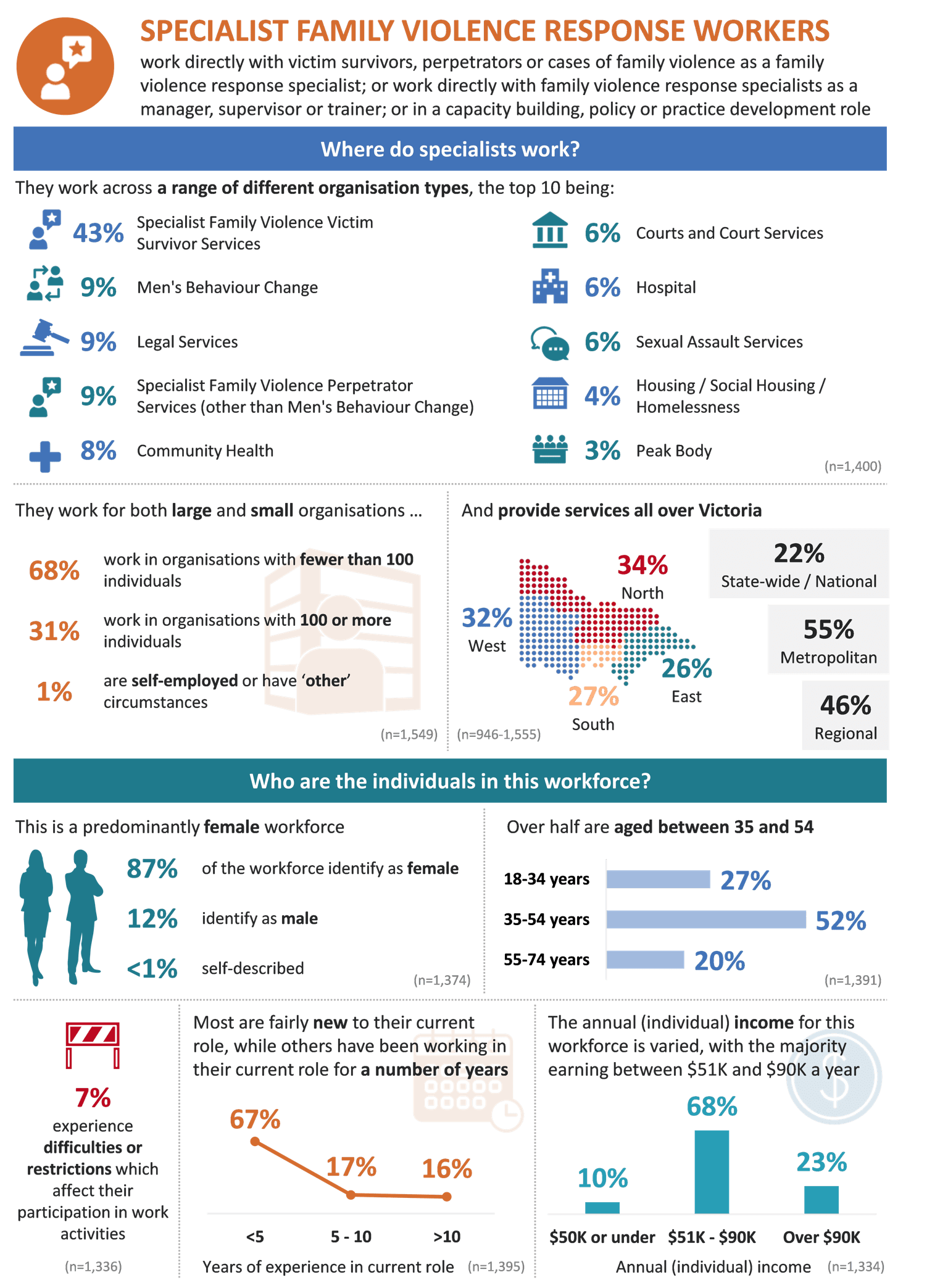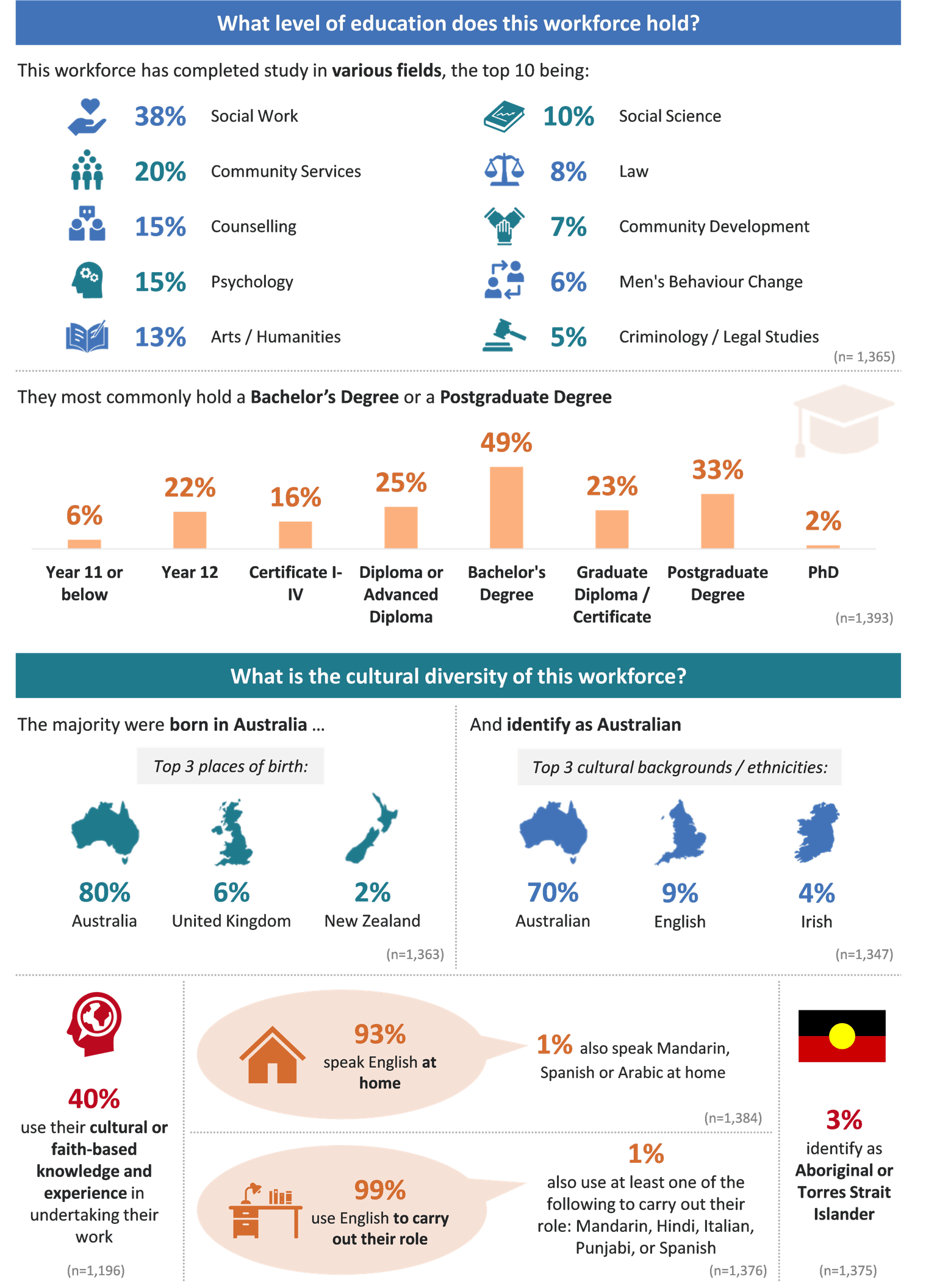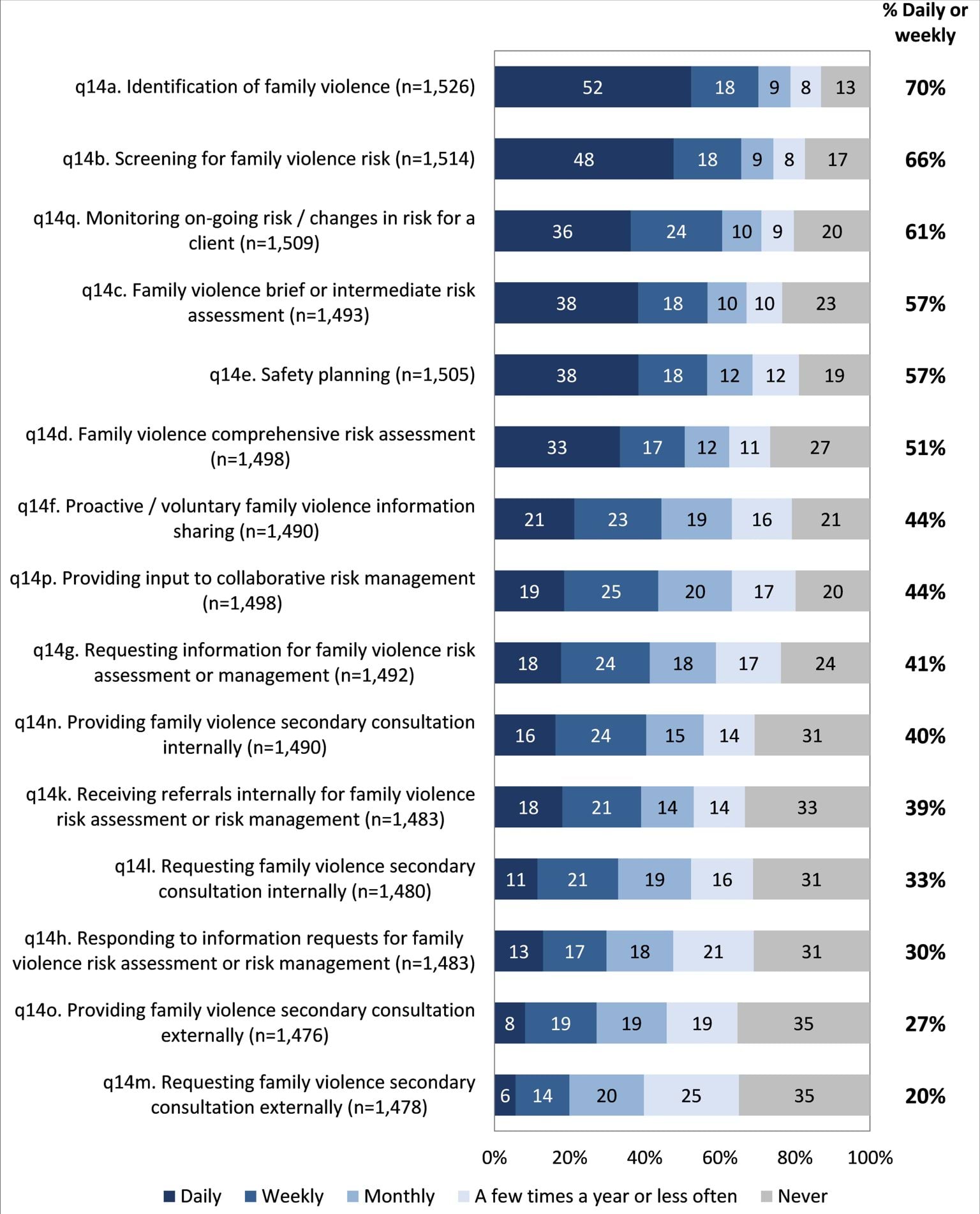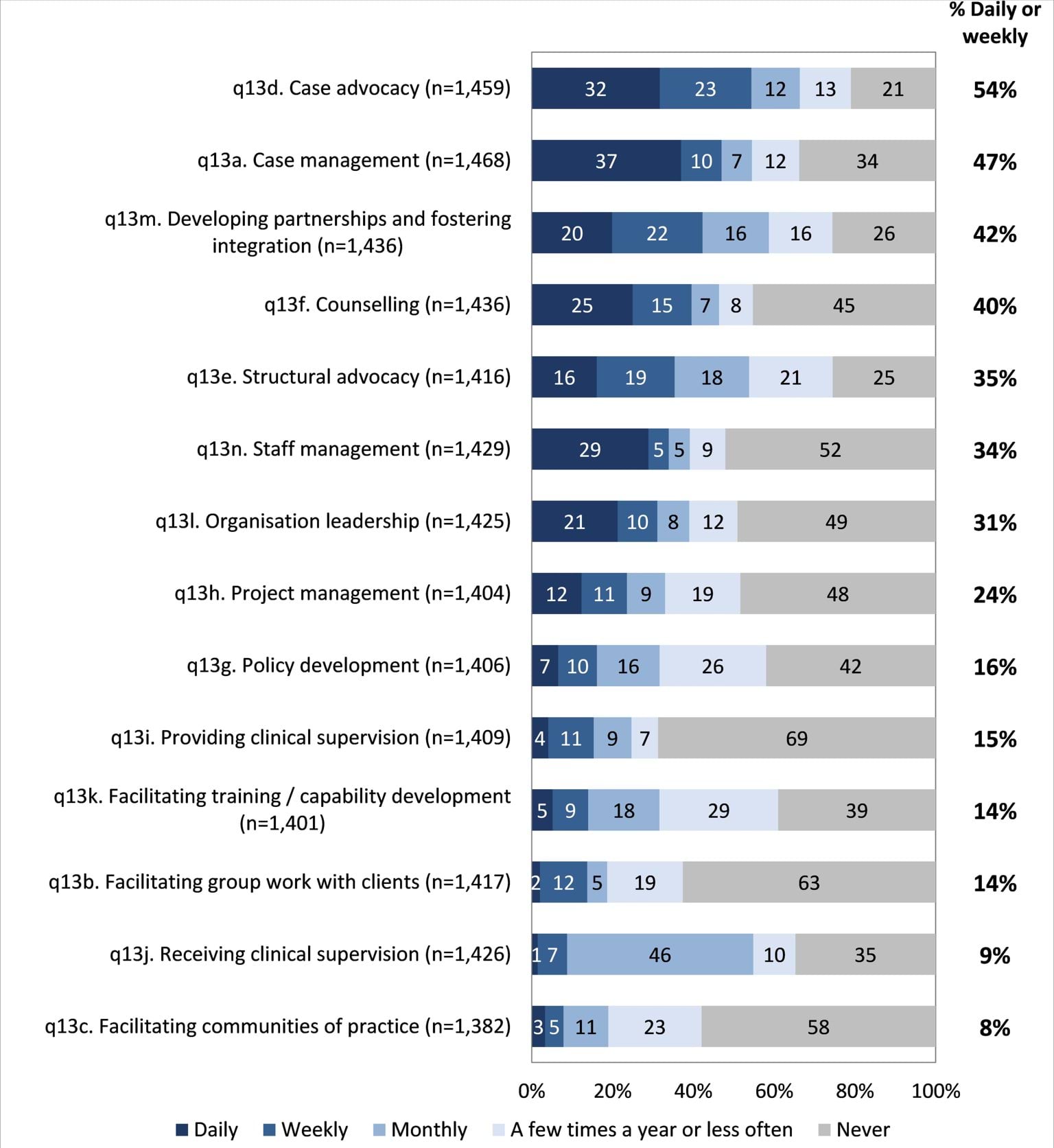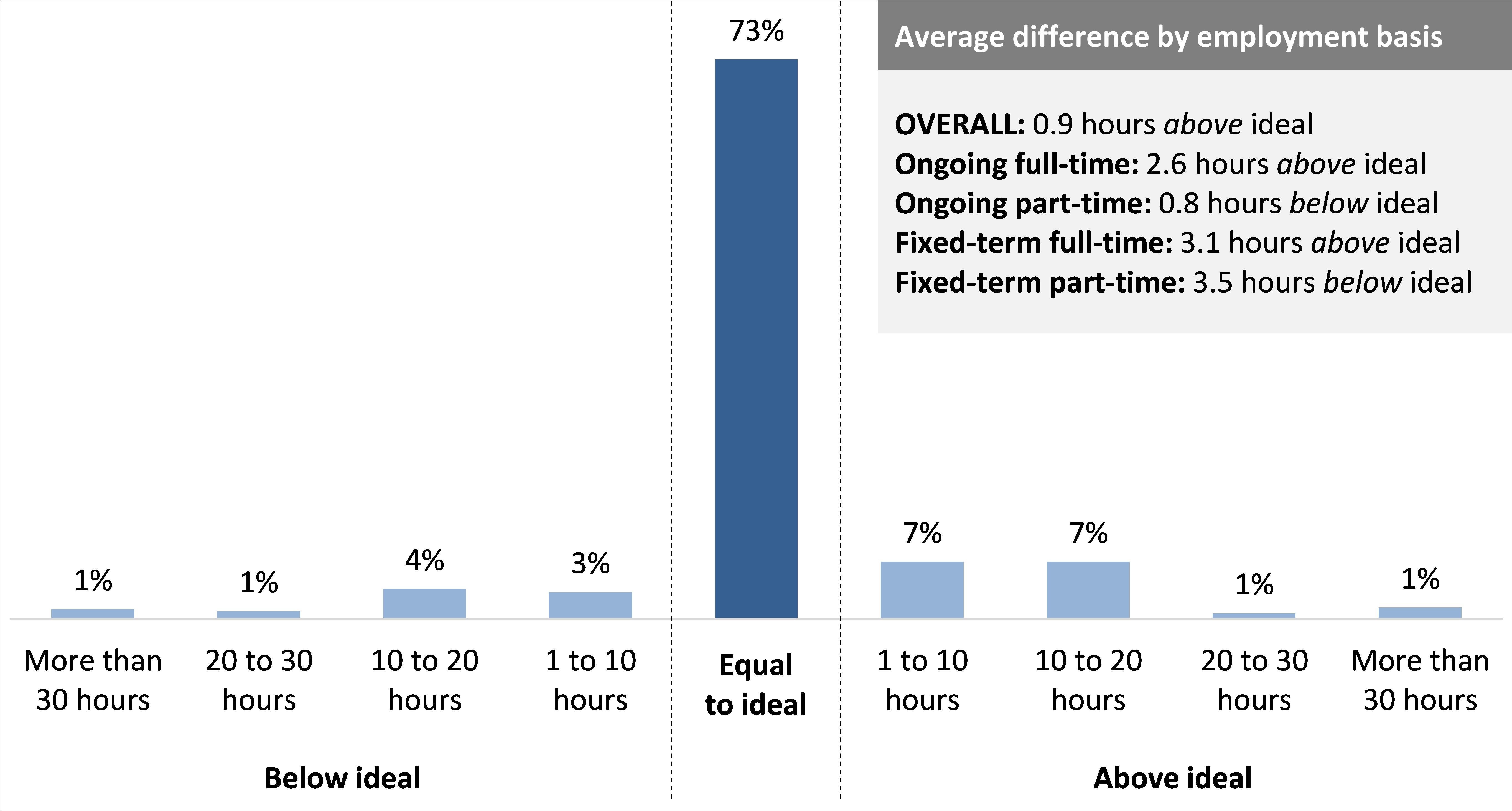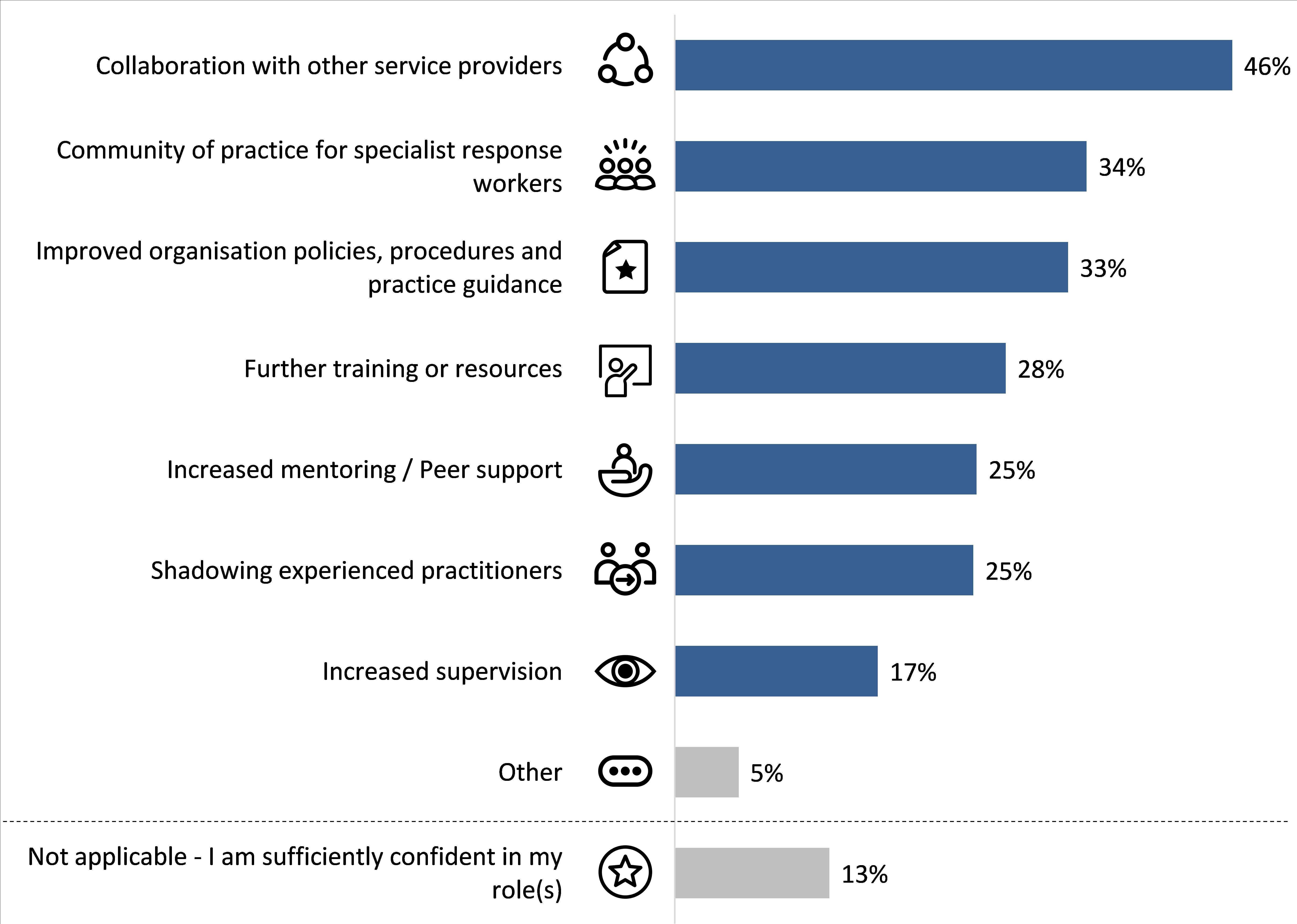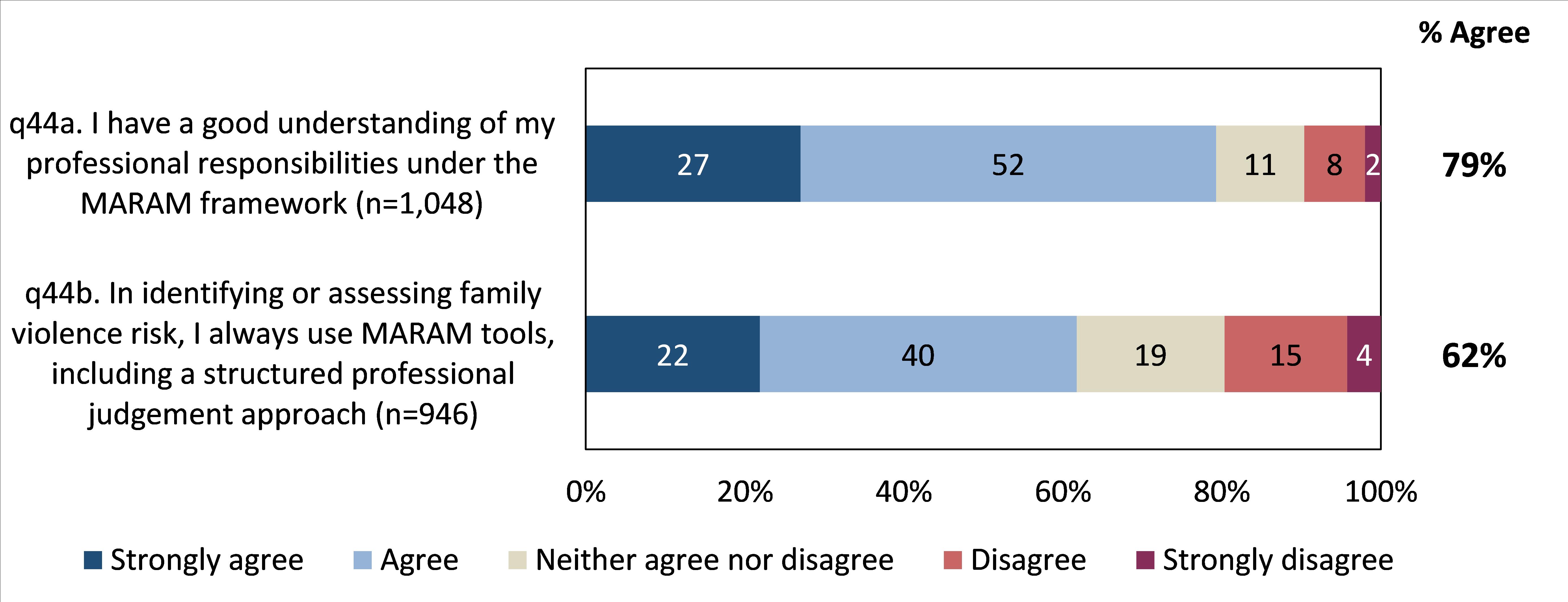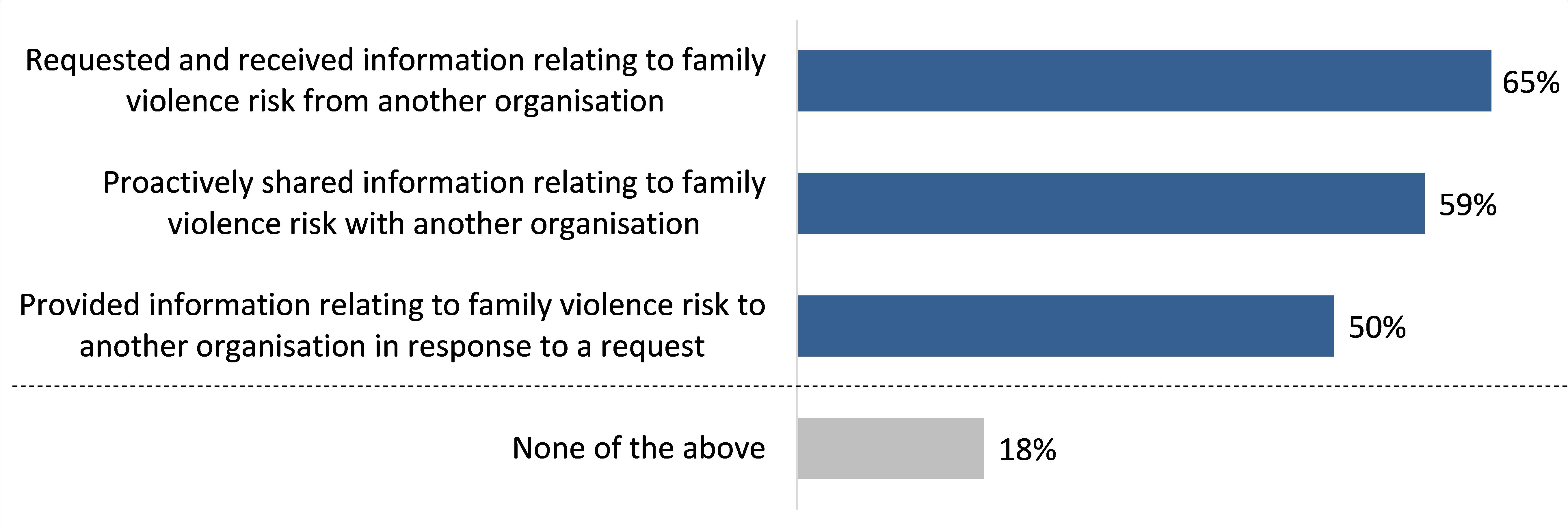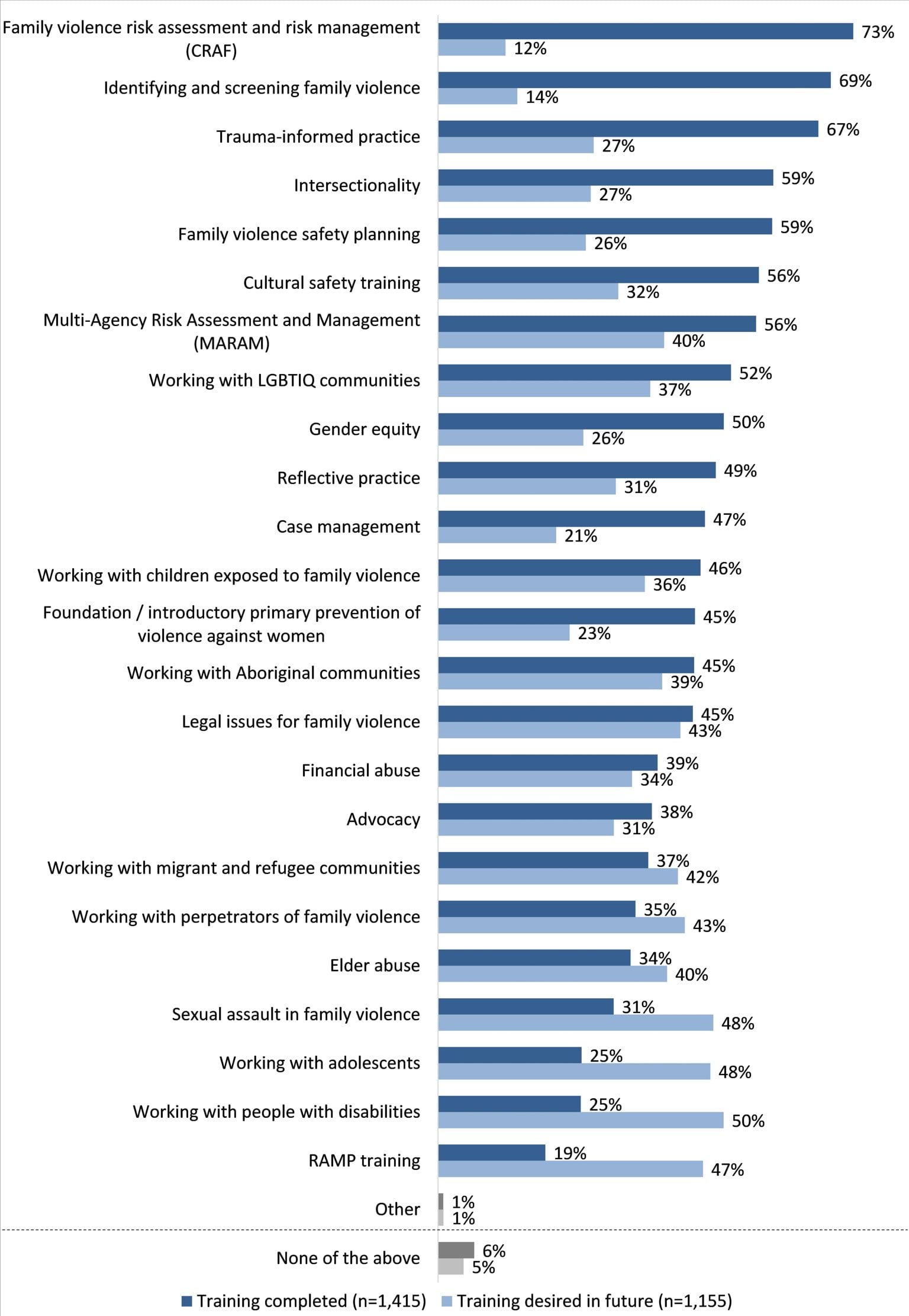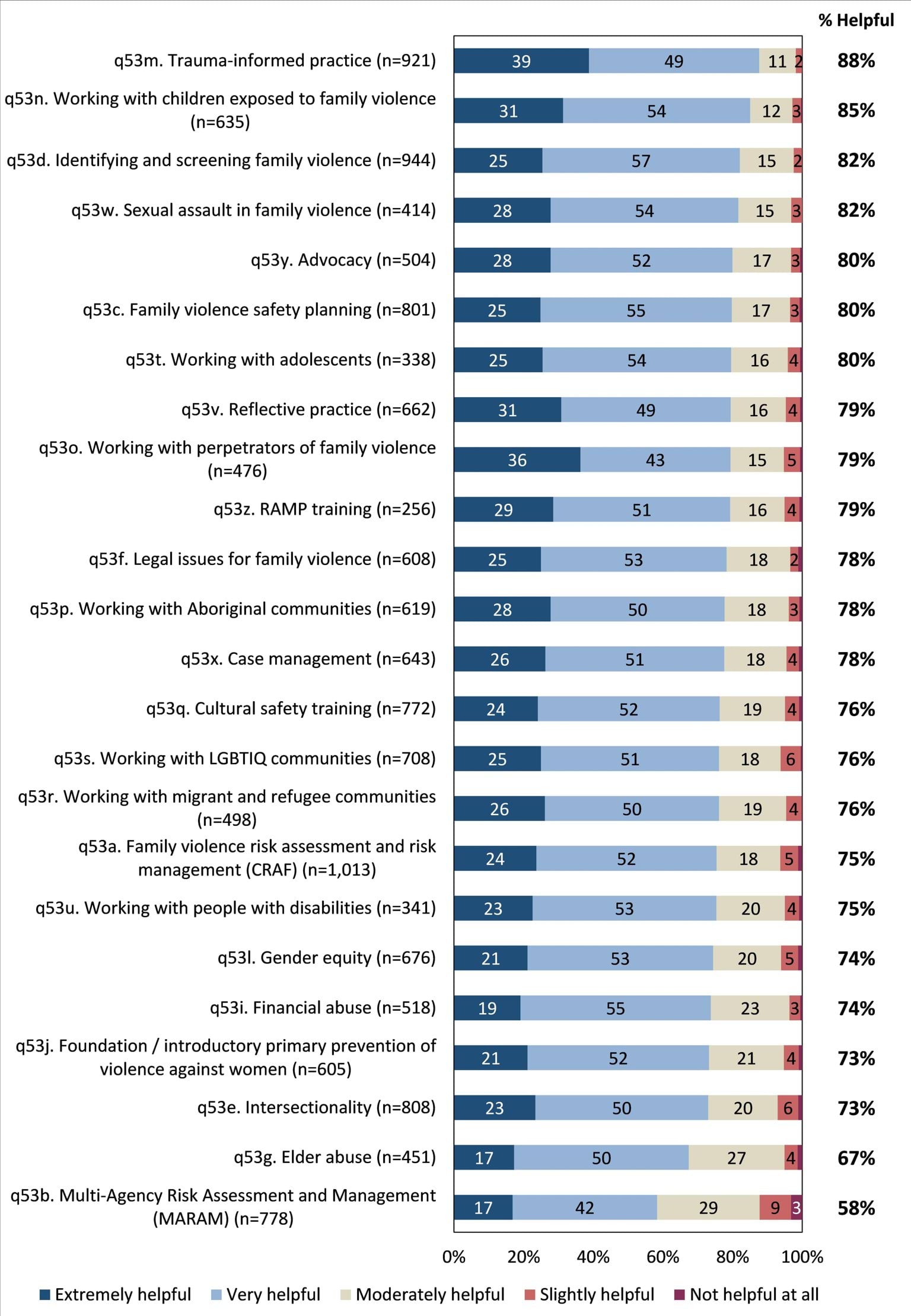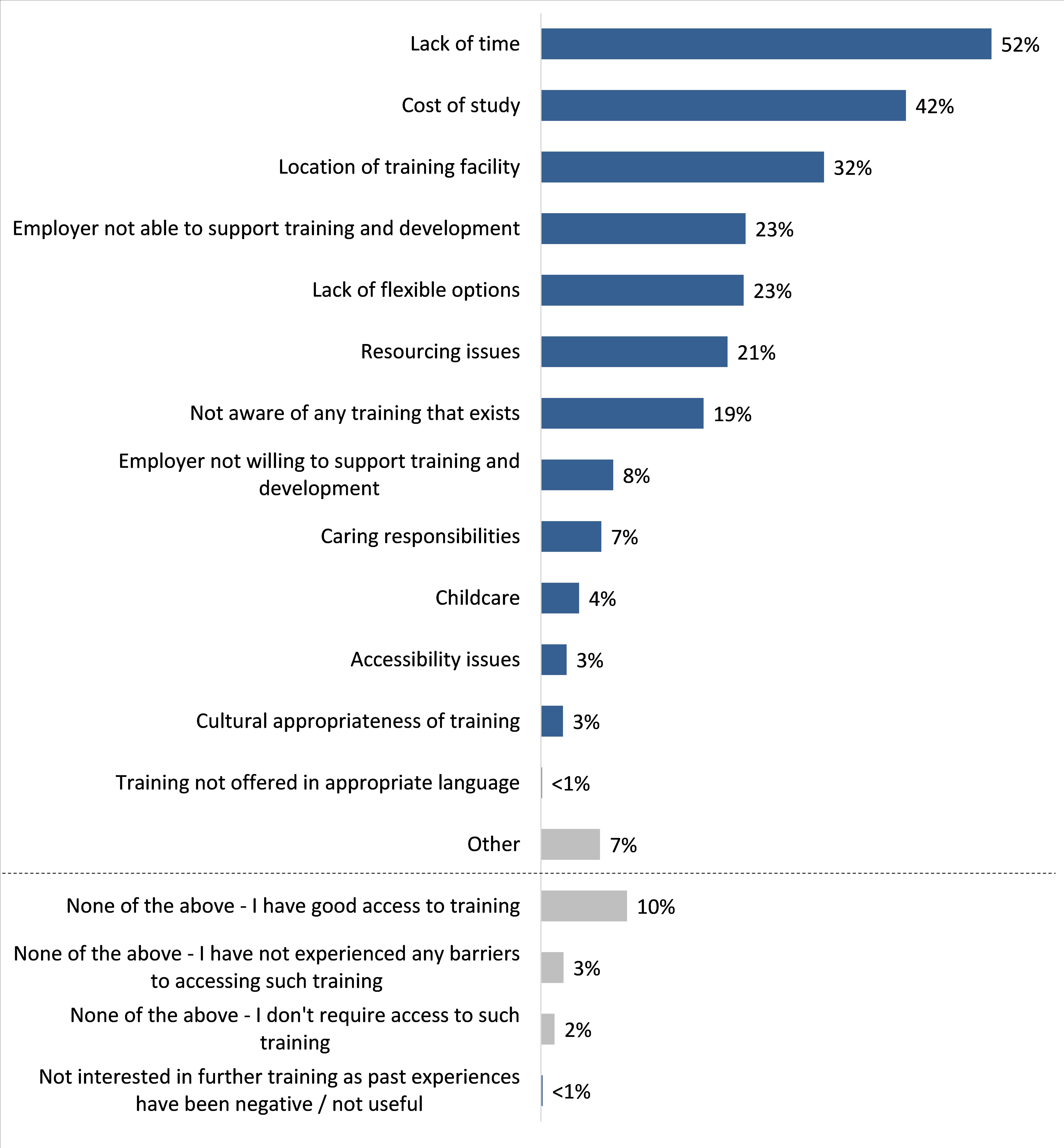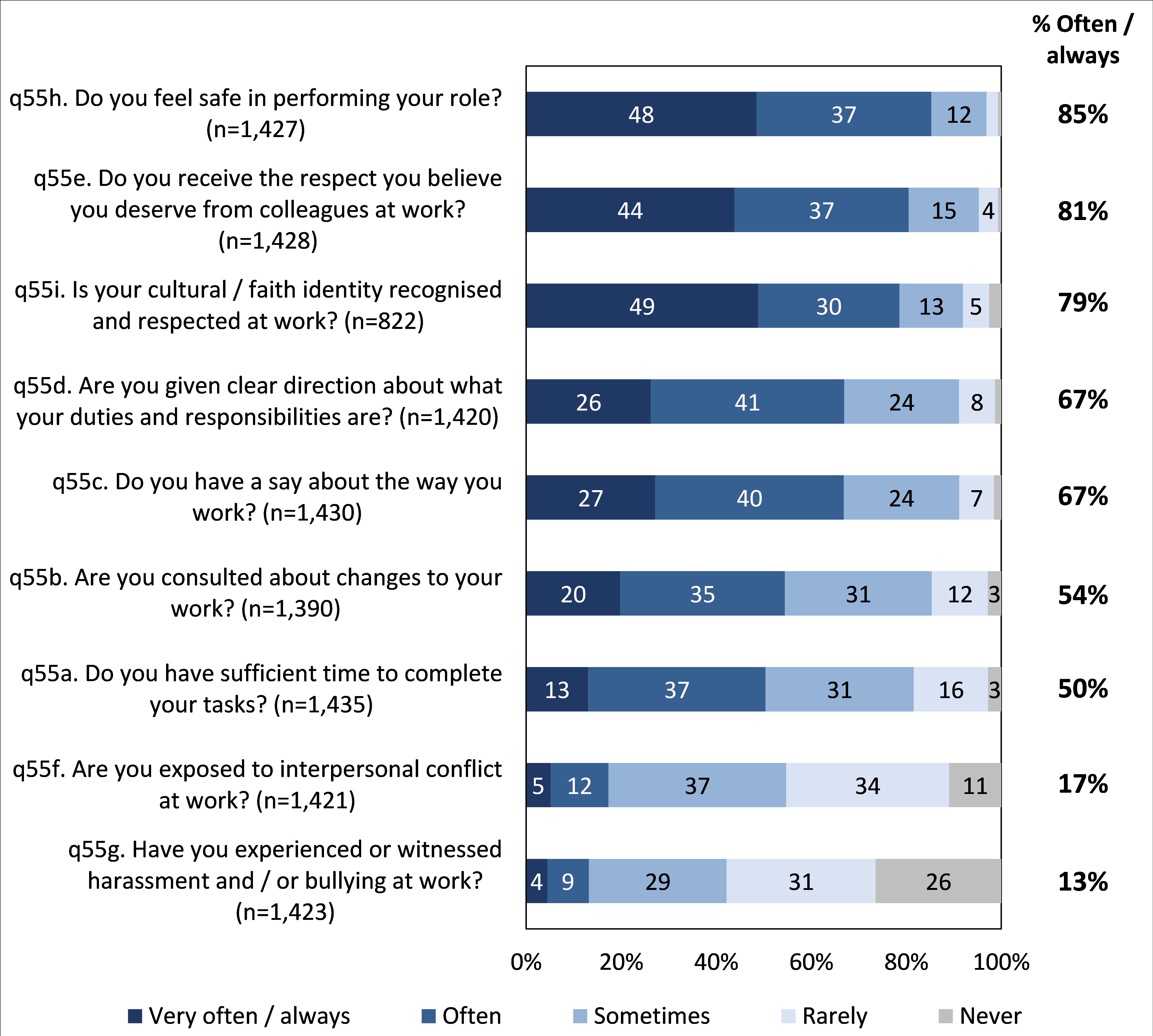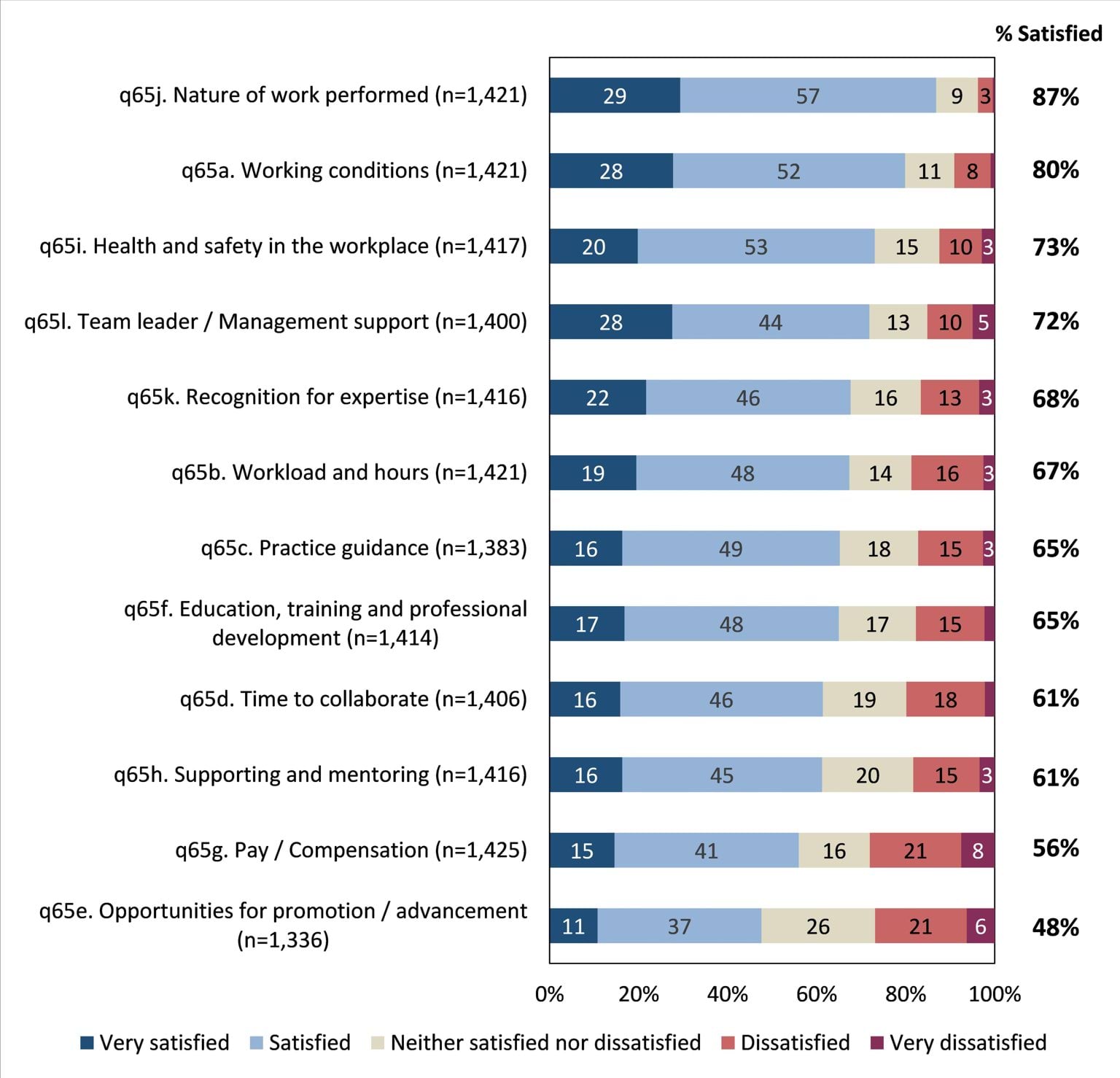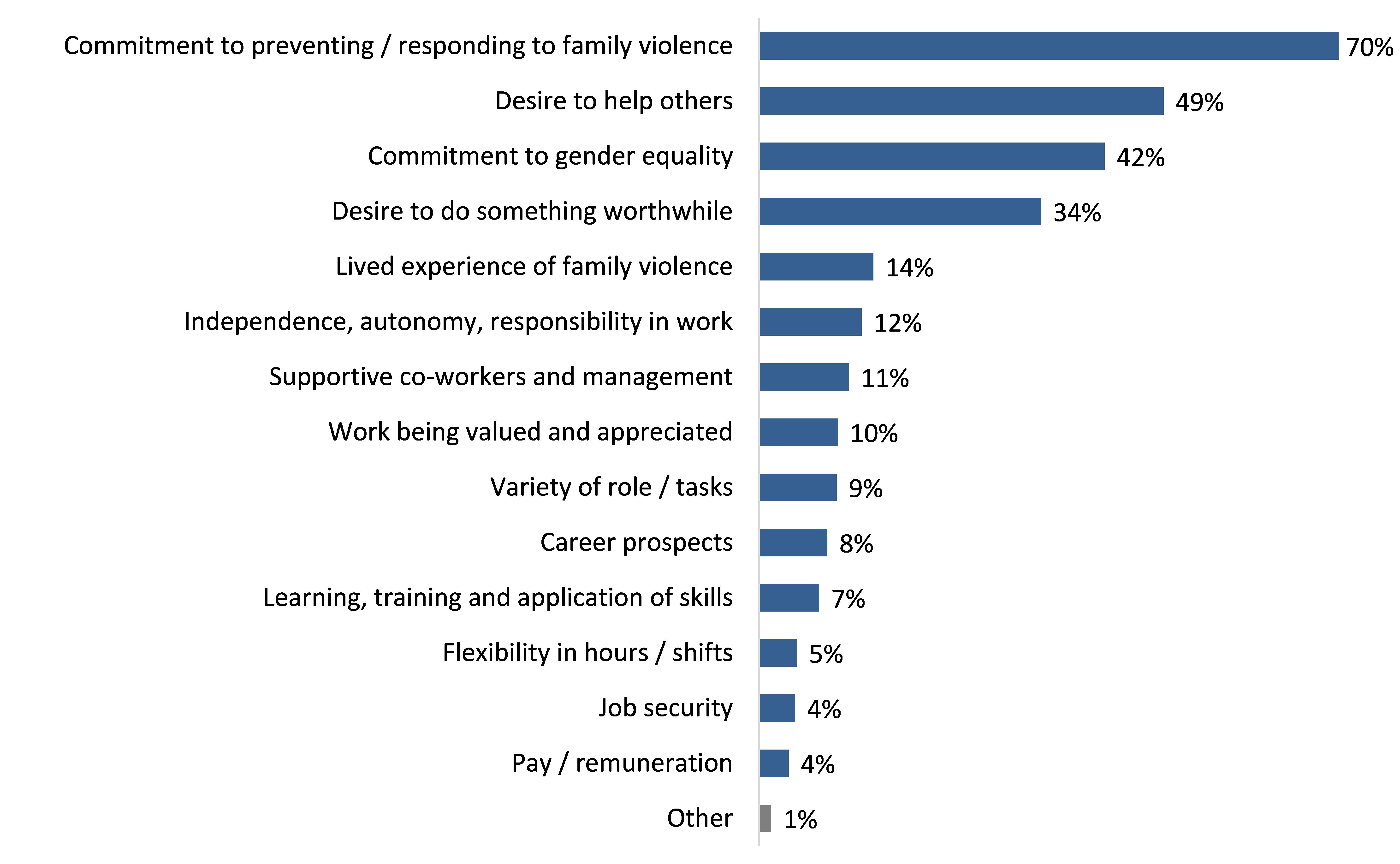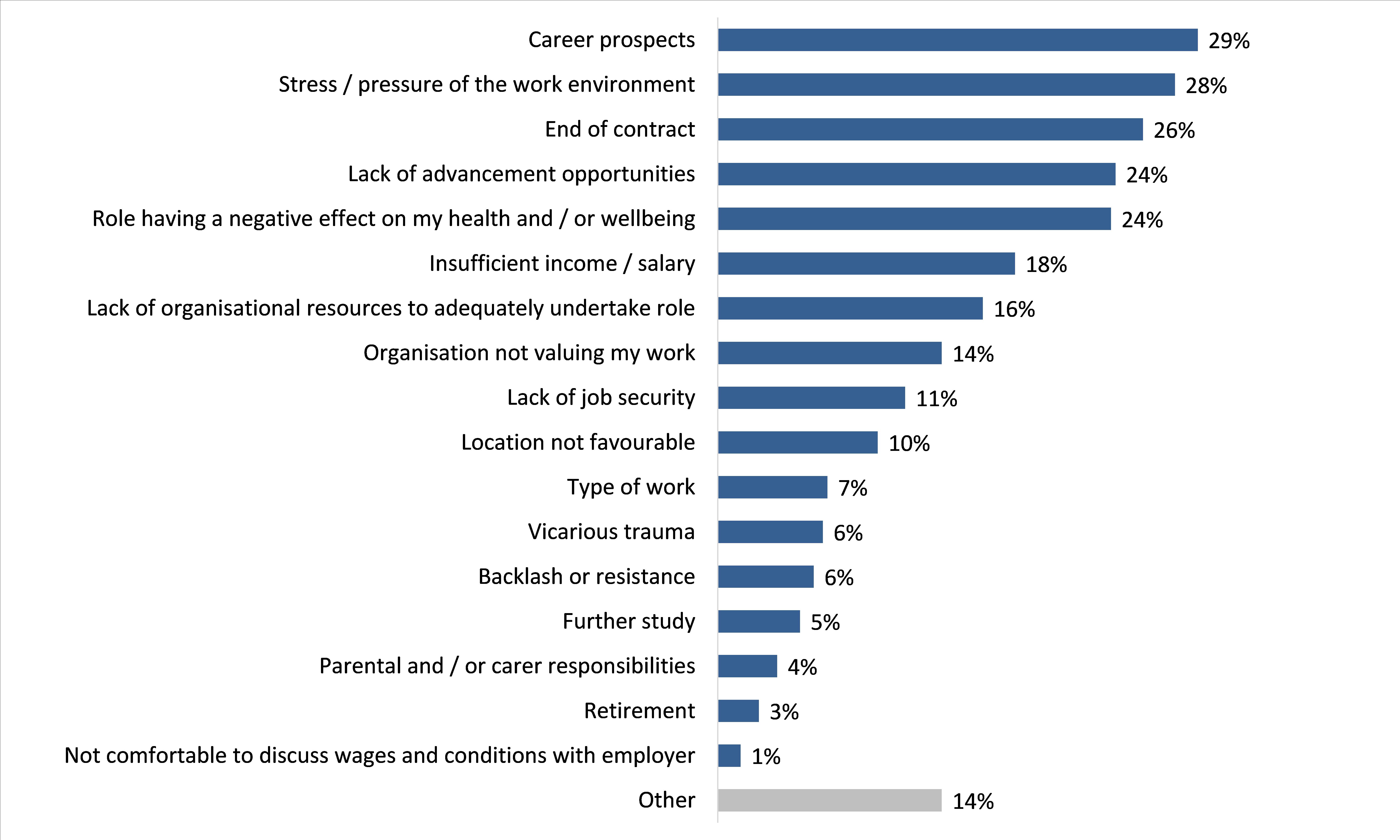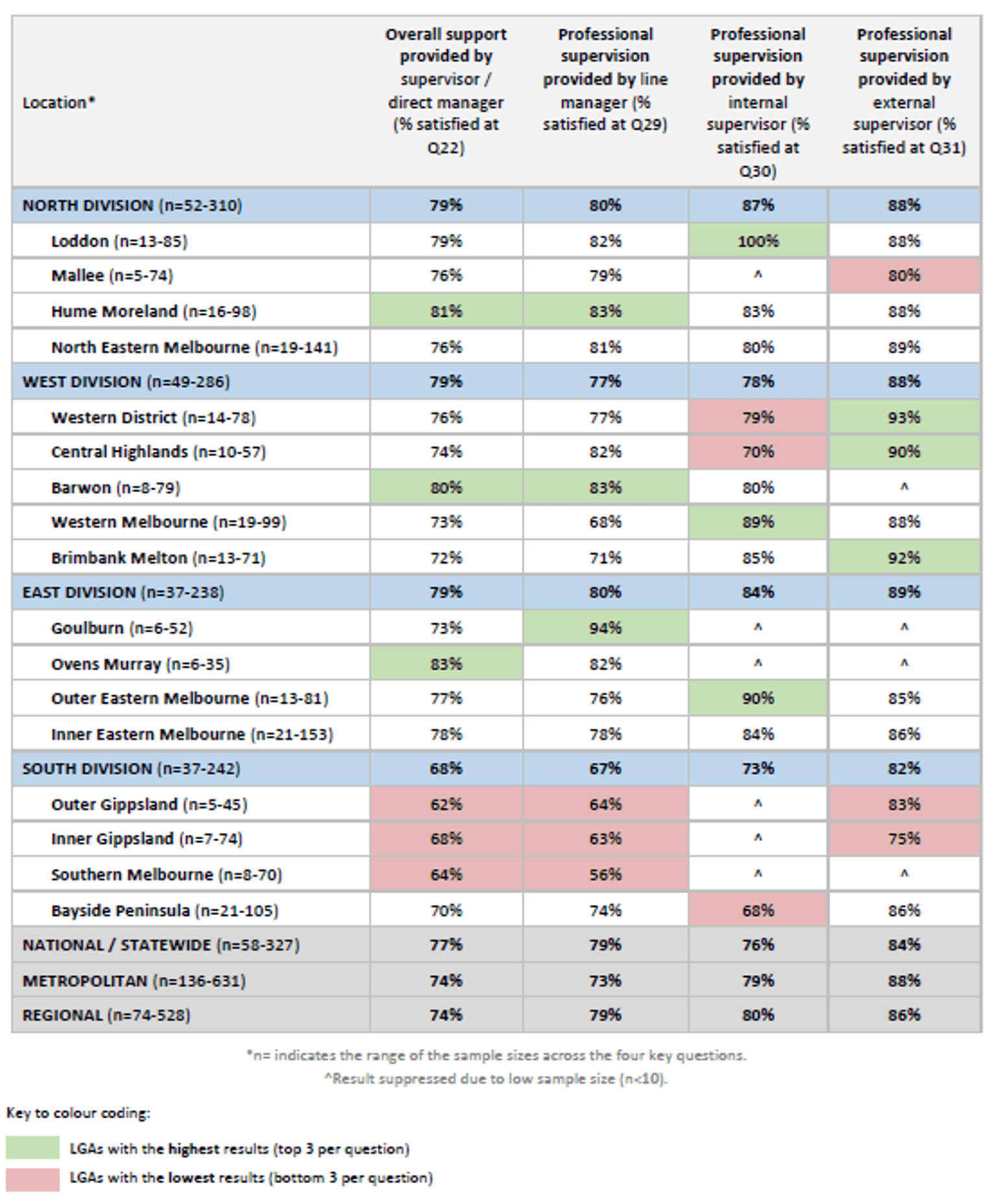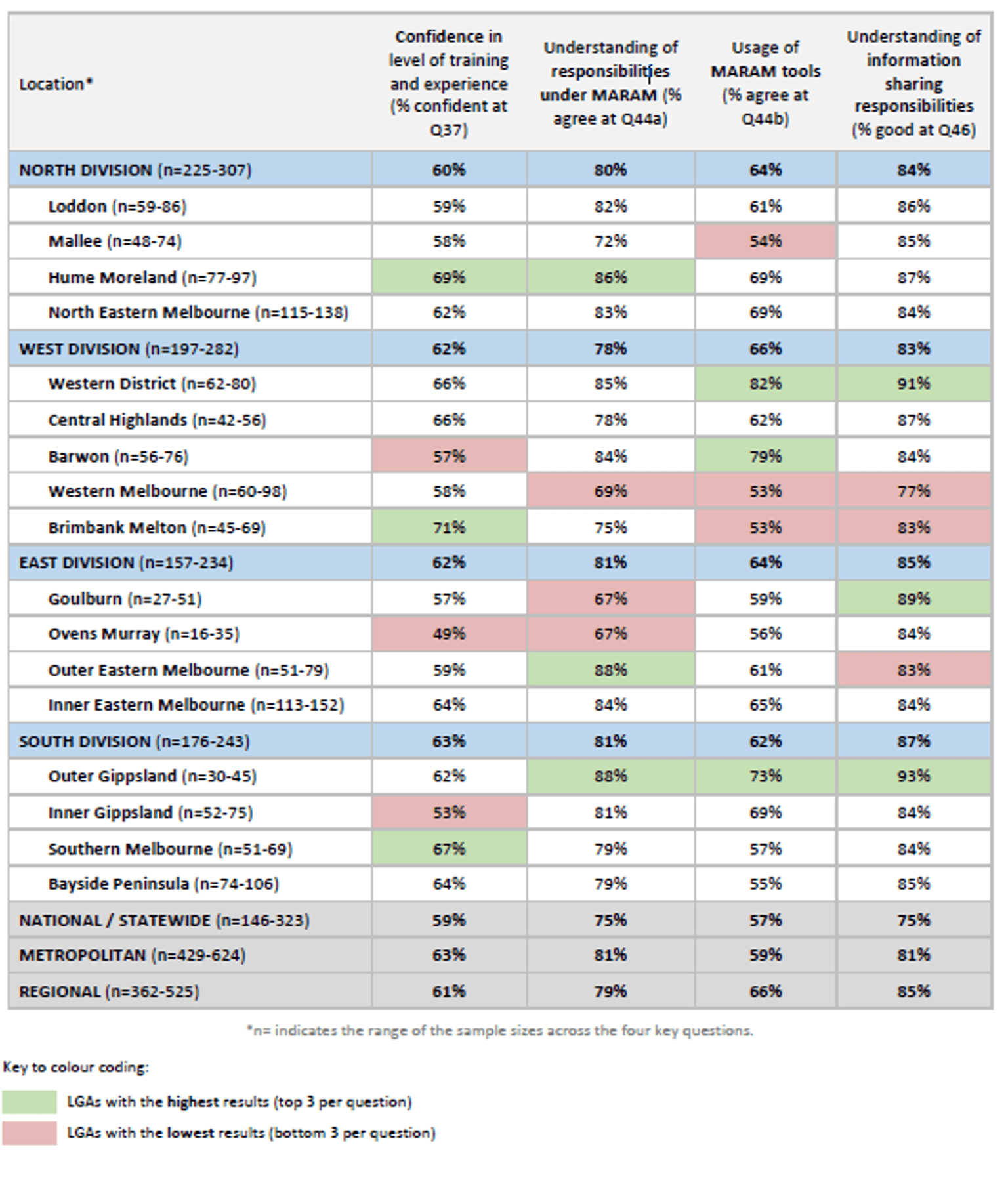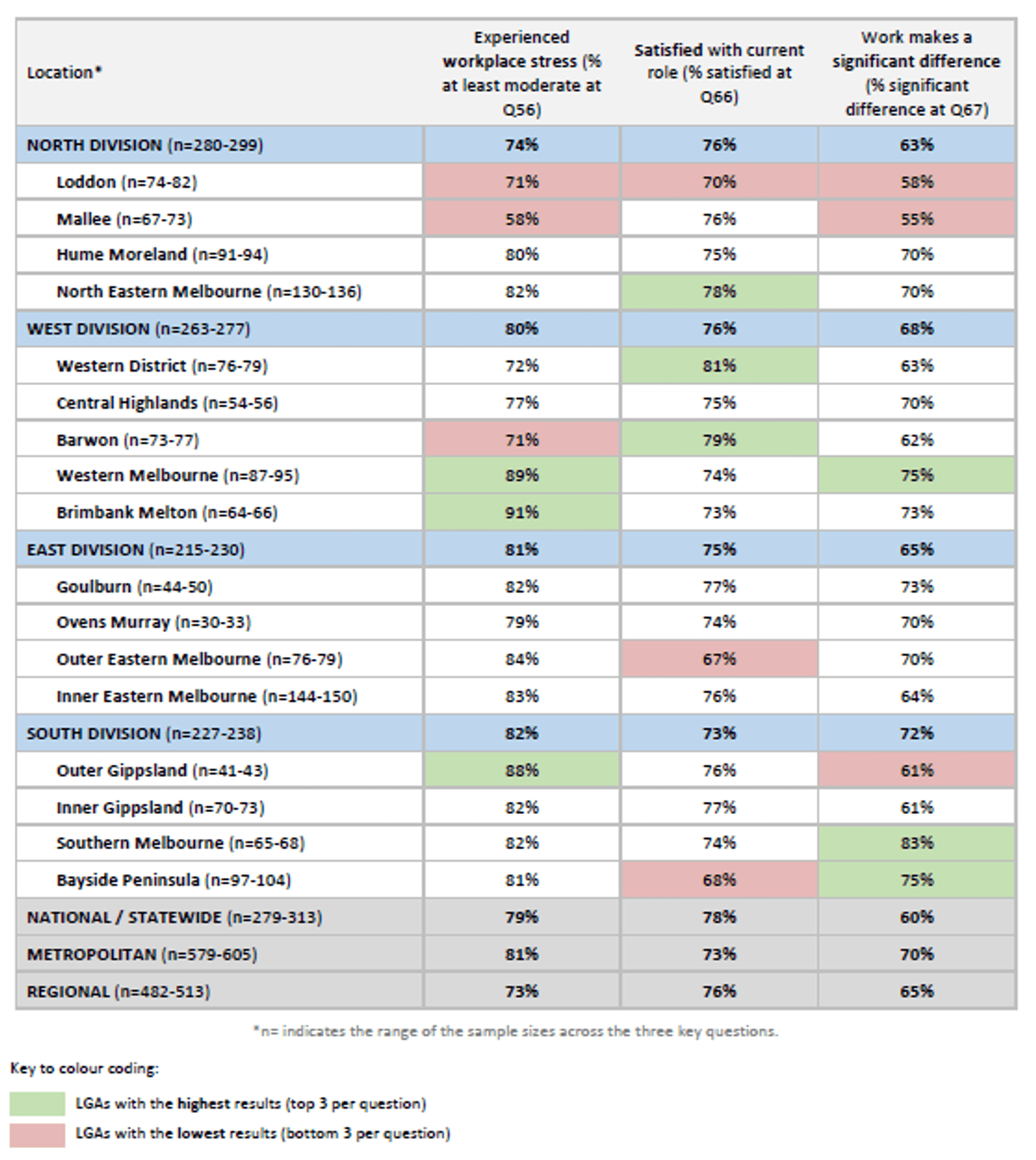- Published by:
- Family Safety Victoria
- Date:
- 31 May 2021
This report details the 2019-20 workforce census findings for the specialist family violence response workforce.
Introduction
This chapter provides a detailed background to the 2019-20 workforce census, including questionnaire development, consultation, delivery and methodology.
Background
In March 2016, the Royal Commission into Family Violence (RCFV) delivered a multi-volume report with 227 recommendations directed at improving the foundations of the system, seizing opportunities to transform the way that the Victorian Government responds to family violence, and building the structures that will guide and oversee a long-term reform program that deals with all aspects of family violence.
The recommendations of the RCFV highlighted the lack of detailed knowledge and systematic collection of data about family violence and related workforces in Victoria, which has made effective industry and workforce planning challenging. The RCFV recommendations also confirmed the important role that these workforces play in identifying and addressing family violence.
In response to these findings, a commitment was made to undertake a family violence workforce census (the Census) every two years in a continued effort to address this gap. The first Census was conducted in 2017, and in July 2019, Family Safety Victoria (FSV) commissioned ORIMA Research to design and deliver the 2019-20 Census.
Research objectives
The overarching aim of the 2019-20 Census was to assist in deepening the Victorian Government’s understanding of a range of issues in the context of reforms recommended by the RCFV.
More specifically, the Census aimed to:
- provide an evidence base for the analysis required to inform the Victorian Government’s decisions relating to industry planning and associated workforce reforms
- enable a more nuanced understanding of specialist family violence and primary prevention workforces through targeted consultation, surveying, and regional analyses of these workforces.
The findings of this Census will help the Victorian Government to better understand the breadth and nature of workforces that come into contact with family violence; identify opportunities to build on knowledge, support and capability; as well as build on what is known in order to maintain its commitment to keep improving family violence prevention and response in Victoria.
Target groups
Three target groups (workforces) were identified for the Census, as detailed in Table 1. This report presents the 2019-20 Census findings for the first target group listed – those who completed the Census in a specialist family violence response capacity1.
Table 1: Target groups for the workforce census (workforces)
| Workforce | Definition and example roles |
|---|---|
|
Specialist family violence response |
|
|
Primary prevention of family violence |
|
|
Broader workforces that intersect with family violence |
|
Project development
Footnotes
- Where respondents indicated that they held paid roles across multiple workforces, the initial screening questions directed them to complete the Census in the capacity of only one of these workforces. Please request the full questionnaire by emailing the Centre for Workforce Excellence at cwe@familysafety.vic.gov.au
Executive summary
Summary of findings for the specialist family violence workforce.
Role requirements
The Census identified the diversity of activities undertaken by the specialist family violence response workforce, and the varying frequencies at which these activities were conducted. The family violence response-specific activities most frequently undertaken by this workforce included identifying and screening for family violence risk, and monitoring on-going risk / changes in risk for a client.
Employment conditions
The results indicated that the roles held within the specialist family violence response workforce were highly varied in terms of working hours and contract conditions. Most employees reported that the number of hours they were employed to work was equivalent to the number of hours they ideally wanted to be employed. Over half also worked additional unpaid hours at least ‘sometimes’.
Supervision
The specialist family violence response workforce was satisfied with the quality of support provided to them by their supervisor or direct manager. Having the opportunity to regularly discuss their professional development, or their work more generally, were key drivers of this satisfaction.
Training and confidence
While the specialist family violence response workforce had completed training across a range of topic areas, overall confidence in their level of training and experience was moderate. The findings highlighted MARAM (Multi-Agency Risk Assessment and Management) as a priority area for further / improved training and professional development.
Health and wellbeing
Overall, the results suggested that many within this workforce had experienced stress due to high workload. Despite this, few were dissatisfied in their current role and most felt that they made a difference to people affected by family violence.
Career and future intentions
The results showed that respondents were predominantly motivated to work in the specialist family violence response workforce due to a strong commitment to preventing / responding to family violence.
When asked about their future intentions, four-in-ten reported that they had plans to leave their current role in the next 12 months. The main reasons cited related to career prospects and lack of advancement opportunities, and stress or other negative influences on their health and wellbeing.
Profile of respondents
Profile of respondents who work in a specialist family violence response role.
Role requirements
A summary of the role requirements of the specialist family violence workforce both generally and as they relate to family violence.
Individuals within the specialist family violence response workforce:
- work directly with victim survivors, perpetrators or cases of family violence as a family violence response specialist
- work directly with family violence response specialists as a manager, supervisor or trainer; or in a capacity building, policy or practice development role.
Overall, the Census results identified the diversity of activities undertaken by this workforce, and the varying frequencies at which these activities are conducted.
Respondents were more likely to report that they frequently undertook family violence response-specific activities (such as identifying and screening for family violence risk), and worked on other non-response related activities relatively less frequently (particularly those related to the provision of clinical supervision and facilitation of group work / communities of practice).
Employment conditions
This chapter details the employment conditions of the specialist family violence response workforce.
This includes the nature of contracts held (full-time, part-time, casual or other; ongoing versus fixed-term), average number of hours and days worked, and amount of unpaid work undertaken.
Exploring these conditions can assist in understanding any challenges this workforce may face in undertaking their work, and aid in the interpretation of subsequent results throughout this report.
Overall, the Census results indicated that the roles held within the specialist family violence response workforce were highly varied in terms of working hours and contract conditions (i.e. ongoing versus fixed-term).
Most employees reported that the number of hours they were employed to work was equivalent to the number of hours they ideally wanted to be employed. Over half also worked additional unpaid hours at least ‘sometimes’.
Figure 3 illustrates that respondents were most commonly employed on a full-time basis (58%), while 38% were employed on a part-time basis, and just 3% were casual or sessional employees.
Furthermore, almost three-in-four respondents indicated that they were employed in an ongoing capacity (73%), while 23% held fixed-term roles.
Just over one-in-ten reported that they held at least one additional paid role outside of the specialist family violence response workforce (12%), and 7% held more than one paid role within this workforce.
As shown in Figure 4 overleaf, the majority of the workforce (73%) reported that in the past fortnight, the number of hours they were employed to work was equivalent to the number of hours they ideally wanted to be employed to work in this role. Those who reported that their hours worked were not ideal were slightly more likely to indicate that they worked in excess of their ideal hours (17%), compared to below their ideal hours (10%).
The difference between actual and ideal hours worked naturally varied by basis of employment, with part-time employees (particularly those in fixed-term roles) being generally more likely than full-time employees to report a desire to have been employed for a greater number of hours in the last fortnight.
The majority of respondents were generally paid to undertake their work during normal business hours. Around one-in-five reported that they were frequently1 paid to undertake their work after hours on weekdays (19%), while 11% were frequently paid to work on weekends (see Figure 5).
Furthermore, respondents were also asked to provide comment about any unpaid work that they undertook. Overall, fewer than one-in-three respondents indicated that they frequently worked additional unpaid hours (17% often and 14% very often / always), though a further 26% reported that they sometimes did.
Footnotes
- ‘Often’ or ‘Very often / always’
- Those working in child protection also reported that they frequently undertook paid work outside of normal business hours (20%-33%), however these results should be treated with caution due to the low sample size (n=15).
- Practitioner responsible for partner and family contact responsibilities as part of a Men’s Behaviour Change Program.
Supervision
This chapter explores the extent to which the specialist family violence response workforce felt satisfied with both the quality of support provided by their supervisors and managers, and the quality of professional supervision provided to them by internal and external supervisors.
Overall, the results indicated that workers in the specialist family violence response workforce were satisfied with the quality of support provided to them by their supervisor or direct manager, and that having the opportunity to regularly discuss both their work and their professional development were key drivers of this satisfaction.
Additionally, this workforce was also broadly satisfied with the quality of professional supervision that they received, particularly with external supervisors (from outside of their organisation).
As illustrated in Figure 6, three-quarters of the specialist family violence response workforce reported that they were satisfied with the quality of supervision provided by their supervisor or manager (75%). Few were dissatisfied (14%).
Additionally, many respondents agreed that:
- they have regular opportunities to discuss their work with their supervisor / direct manager (84%, see Figure 7); and
- their supervisor / direct manager encourages and supports their participation in family violence related learning and development or training opportunities (84%).
Though still fairly high, specialists were less likely to feel that they had regular opportunities to engage in reflective practice1, with 67% agreeing that this was the case.
To determine what was most important in influencing the overall levels of satisfaction with support provided by supervisors/managers amongst this workforce, regression analysis was undertaken. The results suggest that the most influential drivers of satisfaction were having regular opportunities to discuss both their work generally, and their professional development.
Professional supervision
Key results by organisation type are shown in Table 3 below.
| Organisation type | Overall support provided by supervisor / direct manager (Q22) | Professional supervision provided by line manager (Q29) | Professional supervision provided by internal supervisor (Q30) | Professional supervision provided by external supervisor (Q31) |
|---|---|---|---|---|
|
Overall workforce (n=271-1,500)* |
75% |
76% |
78% |
86% |
|
Specialist family violence victim survivor services (n=94-576) |
75% |
77% |
82% |
86% |
| Specialist family violence perpetrator services / Men's behaviour change (n=48-195) |
73% |
76% |
75% |
83% |
| Aboriginal Community Controlled Organisation (n=6-38) |
63% |
67% |
Supressed (low sample size) |
Supressed (low sample size) |
| Alcohol or other drug services (n=9-41) |
83% |
75% |
Supressed (low sample size) |
86% |
| Victims assistance (n=7-37) |
73% |
56% |
Supressed (low sample size) |
60% |
| Peak body (n=3-45) |
76% |
88% |
Supressed (low sample size) |
88% |
| Women’s health (n=4-37) |
70% |
75% |
Supressed (low sample size) |
88% |
| Child protection (n=4-14) |
86% |
Supressed (low sample size) |
Supressed (low sample size) |
Supressed (low sample size) |
| Community health (n=17-110) |
70% |
67% |
94% |
93% |
| Courts and court services (n=17-84) |
69% |
79% |
71% |
71% |
| Family safety contact (n=6-37) |
70% |
82% |
Supressed (low sample size) |
Supressed (low sample size) |
|
Hospital (n=9-71) |
77% |
64% |
93% |
Supressed (low sample size) |
| Housing / Social housing / Homelessness (n=6-54) |
78% |
84% |
Supressed (low sample size) |
Supressed (low sample size) |
| Legal services (n=18-116) |
74% |
68% |
61% |
79% |
| LGBTIQ services (n=4-25) |
68% |
82% |
Supressed (low sample size) |
90% |
| Mental health services (n=11-44) |
70% |
62% |
100% |
92% |
| Multicultural or settlement services (n=1-16) |
63% |
Supressed (low sample size) |
Supressed (low sample size) |
Supressed (low sample size) |
|
Older people (including elder abuse) services (n=1-15) |
87% |
Supressed (low sample size) |
Supressed (low sample size) |
Supressed (low sample size) |
|
Education and training provider (family violence) (n=6-37) |
76% |
73% |
Supressed (low sample size) |
91% |
| Sexual assault services (n=20-72) |
81% |
78%
|
80% |
90% |
| Regional integration (n=0-14) | 93% | Supressed (low sample size) | Supressed (low sample size) | Supressed (low sample size) |
Footnotes
- Reflective practice, also referred to as critical reflection or reflexivity, is a process of self-examination by a practitioner about their own work; becoming self-aware, considering their thoughts, feelings and assumptions, and examining how these impact upon their work.
- Q23. In your current role, do you provide or receive professional supervision? Multiple responses accepted (n=1,475)
Training and confidence
This chapter discusses the extent to which respondents within the specialist family violence response workforce were confident in their role, as well as any training or professional development they had undertaken in a range of skill and capability areas, generally, and as they relate to family violence.
The Census results demonstrated that while the specialist family violence response workforce had completed training across a range of topic areas, overall confidence in their level of training and experience was moderate.
The findings highlighted MARAM (Multi-Agency Risk Assessment and Management) as a priority area for further / improved training and professional development.
Furthermore, this workforce generally believed that collaborative forms of additional support (i.e. collaboration with other service providers, community of practice for specialist response workers) would be most useful in increasing their confidence in performing their role(s).
In terms of barriers to accessing further training and development, lack of time was the most commonly reported barrier, followed by cost of study and location of training facility.
Confidence
As illustrated in Figure 9, overall, around three-in-five respondents within the specialist family violence response workforce indicated that they were ‘extremely’ or ‘very’ confident that they have had enough training and experience to perform their role(s) effectively (61%). In contrast, just 9% reported that they were ‘slightly’ or ‘not at all’ confident.
Respondents within the specialist family violence response workforce felt that the following additional support would be most useful in increasing their confidence in performing their role(s) (see Figure 10):
- collaboration with other service providers (46%);
- community of practice for specialist response workers (34%); and
- improved organisation policies, procedures and practice guidance (33%).
Conversely, fewer than one-in-three respondents indicated that further training, increased mentoring / supervision or shadowing would be beneficial in this context. Furthermore, 13% reported that they felt sufficiently confident in their role, and therefore did not require additional support.
Results differed by age – younger respondents aged under 35 were considerably more likely than older respondents aged over 55 to report that they would benefit from shadowing experienced practitioners (41% versus 17%), improved organisation policies, procedures and practice guidance (47% versus 32%), and increased supervision (28% versus 15%).
MARAM
The family violence Multi-Agency Risk Assessment and Management (MARAM) framework provides guidance to organisations prescribed under regulations that have responsibilities in assessing and managing family violence risk.1 The framework is designed to ensure services are effectively identifying, assessing and managing family violence risk. A range of organisations were prescribed under MARAM in September 2018. Further information about the scope and timeline of MARAM reforms.
92% of respondents within the specialist family violence response workforce indicated that they had heard of the MARAM framework2; and of these,
81% understood that the organisation that they currently worked for was prescribed to align with the MARAM framework.3
Of those who worked for organisations prescribed to align with the MARAM framework, understanding of one’s professional responsibilities under the framework was widespread (79% – see Figure 11). Additionally, a majority (62%) consistently used MARAM tools (including a structured professional judgement approach) in identifying or assessing family violence risk.
81% of respondents within the specialist family violence response workforce felt that they had a ‘good’ or ‘very good’ understanding of their responsibilities to share information relating to family violence risk under relevant Information Sharing Schemes and privacy law.4
Reported understanding of information sharing responsibilities did not vary substantially across most demographic cohorts, but did differ slightly by organisation type (see Table 4 for details).
Figure 12 shows that conduct of information sharing activities under the Family Violence Information Sharing Scheme (FVISS) was moderate, with:
- the most common activity undertaken in the past year being the request and receipt of information relating to family violence risk from another organisation (65%); and
- just under one-in-five indicating that they had not undertaken any information sharing activities under the FVISS in the past year (18%).
Footnotes
- Family Violence Multi-Agency Risk Assessment and Management
- Q42. Before today, had you heard of the Multi-Agency Risk Assessment and Management (MARAM) framework? (n=1,482)
- Q43. Is the organisation that you work for in your current role prescribed to align with the Multi-Agency Risk Assessment and Management (MARAM) framework? (n=1,356)
- Q46. Please rate your understanding of your responsibilities to share information relating to family violence risk under the Family Violence Information Sharing Scheme (FVISS), Child Information Sharing Scheme (CISS) and relevant privacy law. (n=1,343)
- FVISS enables prescribed Information Sharing Entities (ISEs) to share information with each other to assess and manage of family violence risk to children and adults. Some ISEs are prescribed for specific services, rather than the entire organisation. Further detail on the FVISS is available at www.vic.gov.au/about-information-sharing-schemes-and-risk-management-fr…
- Those working in child protection also reported a high level of information sharing activity (90%), however this result should be treated with caution due to the low sample size (n=10).
Training
The specialist family violence response workforce was asked to identify both the family violence prevention and response topics that they had completed training in, and those they would like further training in
The specialist family violence response workforce was asked to identify both the family violence prevention and response topics that they had completed training in, and those they would like further training in.
As illustrated in Figure 13, at least two-in-three respondents had completed training in relation to:
- family violence risk assessment and risk management (CRAF – 73%);
- identifying and screening family violence (69%); and
- trauma-informed practice (67%).
The topics which respondents felt they required further training in were generally those with lower completion rates, including training related to:
- working with people with disabilities (25% had completed training, 50% desired further training);
- working with adolescents (25% had completed training, 48% desired further training);
- sexual assault in family violence (31% had completed training, 48% desired further training); and
- RAMP (19% had completed training, 47% desired further training).
Those who had completed training in each topic area were then asked to assess the degree to which they believed the training had assisted them in undertaking their work more effectively. Figure 14 shows that perceived helpfulness was high across most topic areas, and was highest in relation to training in:
- trauma-informed practice (88% found training in this topic to be ‘extremely’ or ‘very’ helpful);
- working with children exposed to family violence (85% felt this was ‘extremely’ or ‘very’ helpful);
- identifying and screening family violence (82% felt this was ‘extremely’ or ‘very’ helpful); and
- sexual assault in family violence (82% felt this was ‘extremely’ or ‘very’ helpful).
In contrast, although the proportions were not particularly low (still greater than half), respondents were least likely to feel that training undertaken in the following topics was helpful, suggesting that there is an opportunity to review and improve training in these areas:
- MARAM (58% felt this was ‘extremely’ or ‘very’ helpful); and
- elder abuse (67% felt this was ‘extremely’ or ‘very’ helpful).
When asked about barriers to accessing further training and development in relation to family violence response or prevention, the three main barriers identified by respondents were:
- lack of time (52%);
- cost of study (42%); and
- location of training facility (32% – see Figure 15).
Health and wellbeing
This chapter explores the impacts of the work that the specialist family violence response workforce undertakes on their health and wellbeing.
Given the various work-related stressors that this group may encounter, this information is important to understand and may be used to assist in identifying any specific areas of focus to inform plans, processes or strategies to support its workers.
Overall, the results suggested that many within this workforce had experienced stress due to high workload, with over three-quarters reporting that they experienced at least moderate stress in their role.
Of this group, many cited a high volume of work or high demands of their role as a primary reason for their stress (84%). Over 2-in-5 also reported that vicarious trauma was a cause of stress for them when undertaking their work.
Positively, around two-thirds of this workforce felt that their work made a significant difference to people affected by family violence. Additionally, most were satisfied in their current role (75%).
Workplace stressors
Support for negative encounters
Satisfaction with role
Suggestions for improvement
Footnotes
- Q56. On average, how would you rate your level of work-related stress? (n=1,443)
- Q57. What is the primary cause(s) of your work-related stress? Multiple responses accepted (n=482)
- Additionally, 18% believed that their organisation did not have such measures in place, and 23% were unsure. Q58. Does your organisation have processes in place or policies and procedures to recognise and manage vicarious trauma? (n=1,436)
- Q59. Overall, how effective are these processes, policies and / or procedures in assisting you to recognise that you are experiencing vicarious trauma? (n=744)
- Q60. Overall, how effective are these processes, policies and / or procedures in assisting you to manage vicarious trauma? (n=731)
Career and future intentions
This chapter outlines the key motivators for working in the specialist family violence response workforce and explores the future plans/intentions of this group. This information may be useful to inform recruitment and retention strategies.
Overall, the results illustrated that the specialist family violence response workforce were highly motivated by a commitment to preventing / responding to family violence, and a desire to help others.
When asked about their future intentions, half this workforce reported that they did not have plans to leave their current role. Of the 40% who did hold such intentions, their reasons were predominantly due to career prospects and lack of advancement opportunities, stress or other negative influences on their health and wellbeing, or an end of contract.
The main motivator for working in a specialist family violence response role was reported to be a commitment to preventing and responding to family violence – with 70% citing this reason. Almost half of this workforce also indicated that they were motivated by a desire to help others (49%).
This workforce was least motivated by pay/remuneration and job security (4% each).
When asked about their employment status prior to commencing their current role in the specialist family violence response workforce, a range of responses were provided. Overall, 41% indicated that they had held a role with another organisation or agency in the sector (within Victoria), 23% had been working in a related sector, 14% in an unrelated sector, and 13% had been studying.
Future intentions
Footnotes
- Q71. Thinking about your future, do you have plans to leave your current role? (n=1,409)
- Asked only of those who did not currently hold any roles in the primary prevention of family violence workforce.
The Orange Door - key findings
This chapter presents the key Census results for respondents who indicated that they currently worked in The Orange Door.
This chapter presents the key Census results for respondents who indicated that they currently worked in The Orange Door (10%; n=160). This cohort primarily comprised specialist family violence workers (29%), child and family services workers (14%), hub team leaders (10%), and men’s family violence workers (9%).
